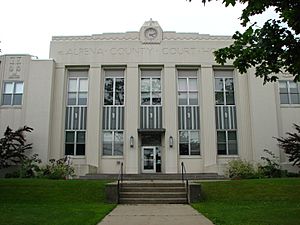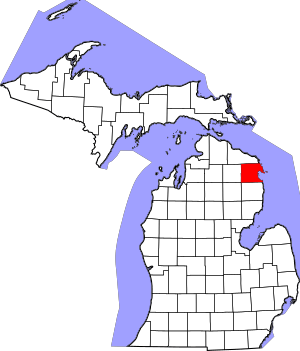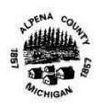Alpena County, Michigan facts for kids
Quick facts for kids
Alpena County
|
||
|---|---|---|

Alpena County Courthouse
|
||
|
||

Location within the U.S. state of Michigan
|
||
 Michigan's location within the U.S. |
||
| Country | ||
| State | ||
| Founded | February 7, 1857 | |
| Seat | Alpena | |
| Largest city | Alpena | |
| Area | ||
| • Total | 1,695 sq mi (4,390 km2) | |
| • Land | 572 sq mi (1,480 km2) | |
| • Water | 1,123 sq mi (2,910 km2) 66%% | |
| Population
(2020)
|
||
| • Total | 28,907 | |
| • Estimate
(2023)
|
28,904 |
|
| • Density | 66/sq mi (25/km2) | |
| Time zone | UTC−5 (Eastern) | |
| • Summer (DST) | UTC−4 (EDT) | |
| Congressional district | 1st | |
Alpena County (/ælˈpiːnə/ al-PEE-nə) is a county in the U.S. state of Michigan. As of the 2020 census, the population was 28,907. The county seat is Alpena. It is considered to be part of Northern Michigan.
Alpena County comprises the Alpena, MI Micropolitan Statistical Area.
Contents
History

The county was created by the Michigan Legislature in 1840 as Anamickee County, then renamed in 1843 to Alpena County, a pseudo-Native American word — a neologism coined by Henry Schoolcraft, meaning "a good partridge country." This was part of a much larger effort to rename a great many of the Michigan counties at the time. The Thunder Bay Band of Chippewa and Ottawa, the original indigenous inhabitants of the area, merged with the Mackinac Bands of Chippewa and Ottawa Indians in the mid 1800s under Chief Way-ge-maw-waw-be. The county was officially organized in 1857.
Geography
According to the U.S. Census Bureau, the county has a total area of 1,695 square miles (4,390 km2), of which 572 square miles (1,480 km2) is land and 1,123 square miles (2,910 km2) (66%) is water.
Alpena County is in the northeast of the mitten-shaped Lower Peninsula of Michigan. Lake Huron and Thunder Bay are to the east, Alcona County to the south, Oscoda County to the southwest, Montmorency County to the west, and Presque Isle County to the north. Most of the county is drained by the Thunder Bay River and its tributaries. The Mackinaw State Forest occupies large tracts of land in the county. The Thunder Bay National Marine Sanctuary is offshore adjacent to the county.
The 45th parallel bisects the county, meaning it is halfway between the North Pole and the equator.
Several islands in Thunder Bay are part of the Michigan Islands National Wildlife Refuge. There are automated lighthouses on Middle Island and Thunder Bay Island.
Geographic features
- Thunder Bay River
- Long Lake
- Grand Lake
Glaciers shaped the area, creating a unique regional ecosystem. A large portion of the area is so-called Grayling outwash plain, consisting of broad outwash plain including sandy ice-disintegration ridges; jack pine barrens, some white pine-red pine forest, and northern hardwood forests. Large lakes were created by glacial action. Some of the inland lakes are truly massive.
Adjacent counties
- Alcona County - south
- Oscoda County - southwest
- Montmorency County - west
- Presque Isle County - north
Major highways
 US 23 serves Alpena on its way along the Lake Huron shoreline. To the north, it passes past Long Lake and Grand Lake, thence to Rogers City, Michigan, through Cheboygan, Michigan, and on to Mackinaw City, Michigan, where it ends and connects to I-75 and the Mackinac Bridge.
US 23 serves Alpena on its way along the Lake Huron shoreline. To the north, it passes past Long Lake and Grand Lake, thence to Rogers City, Michigan, through Cheboygan, Michigan, and on to Mackinaw City, Michigan, where it ends and connects to I-75 and the Mackinac Bridge. M-32 ends its 100-mile (160 km) easterly cross-peninsular route from Lake Michigan to Lake Huron within downtown Alpena at an intersection with US 23.
M-32 ends its 100-mile (160 km) easterly cross-peninsular route from Lake Michigan to Lake Huron within downtown Alpena at an intersection with US 23. M-65 is a more direct route to the south than US 23, which meanders along the lake shore through many villages and towns. M-65 goes north to Rogers City.
M-65 is a more direct route to the south than US 23, which meanders along the lake shore through many villages and towns. M-65 goes north to Rogers City.
National protected area
Communities

City
- Alpena (county seat)
Village
- Hillman (partially)
Charter township
Civil townships
- Green Township
- Long Rapids Township
- Maple Ridge Township
- Ossineke Township
- Sanborn Township
- Wellington Township
- Wilson Township
Census-designated place
Other unincorporated communities
Demographics
| Historical population | |||
|---|---|---|---|
| Census | Pop. | %± | |
| 1860 | 290 | — | |
| 1870 | 2,756 | 850.3% | |
| 1880 | 8,789 | 218.9% | |
| 1890 | 15,581 | 77.3% | |
| 1900 | 18,254 | 17.2% | |
| 1910 | 19,965 | 9.4% | |
| 1920 | 17,869 | −10.5% | |
| 1930 | 18,574 | 3.9% | |
| 1940 | 20,766 | 11.8% | |
| 1950 | 22,189 | 6.9% | |
| 1960 | 28,556 | 28.7% | |
| 1970 | 30,708 | 7.5% | |
| 1980 | 32,315 | 5.2% | |
| 1990 | 30,605 | −5.3% | |
| 2000 | 31,314 | 2.3% | |
| 2010 | 29,598 | −5.5% | |
| 2020 | 28,907 | −2.3% | |
| 2023 (est.) | 28,904 | −2.3% | |
| U.S. Decennial Census 1790-1960 1900-1990 1990-2000 2010-2018 |
|||
The 2010 United States census indicated Alpena County had a 2010 population of 29,598. This is a decrease of -1,716 people from 2000. Overall, the county had a -5.5% growth rate during this ten-year period. In 2010 there were 12,791 households and 8,164 families in the county. The population density was 51.8 per square mile (20.0 square kilometers). By the 2020 census, the county population was 28,907.
There were 16,053 housing units at an average density of 28.1 per square mile (10.8 square kilometers). Among the population at the time, 97.5% of the population were White, 0.5% Native American, 0.5% Asian, 0.3% Black or African American, 0.1% of some other race and 1.1% of two or more races. 1.0% were Hispanic or Latino (of any race). 26.8% were of German, 19.5% Polish, 12.9% French, French Canadian or Cajun, 8.1% English, 6.4% Irish and 5.7% American ancestry.
There were 12,791 households, out of which 25.3% had children under the age of 18 living with them, 50.0% were husband and wife families, 9.8% had a female householder with no husband present, 36.2% were non-families, and 30.8% were made up of individuals. The average household size was 2.27 and the average family size was 2.81.
In the county, the population was spread out, with 20.9% under age of 18, 7.4% from 18 to 24, 20.8% from 25 to 44, 31.5% from 45 to 64, and 19.5% who were 65 years of age or older. The median age was 46 years. For every 100 females there were 96.4 males. For every 100 females age 18 and over, there were 94.1 males.
The 2010 American Community Survey 3-year estimate indicated the median income for a household in the county was $36,242 and the median income for a family was $46,718. Males had a median income of $27,002 versus $15,670 for females. The per capita income for the county was $21,713. About 2.5% of families and 16.9% of the population were below the poverty line, including 27.2% of those under the age 18 and 10.0% of those age 65 or over.
Media
The Alpena News is the daily newspaper of record for much of Northeast lower peninsula of Michigan. For a complete list of other media, see Alpena, Michigan.
Arts and culture
Museums
- Besser Museum for Northeast Michigan
- Thunder Bay National Marine Sanctuary.
Historical markers
There are seven recognized historical markers in the county:
- Alpena County Courthouse
- Alpena City Hall
- The Daniel Carter Family
- First Congregational Church [Alpena]
- Monarch Mill
- St. Bernard Catholic Church
- World's Largest Cement Plant
See also
 In Spanish: Condado de Alpena para niños
In Spanish: Condado de Alpena para niños


